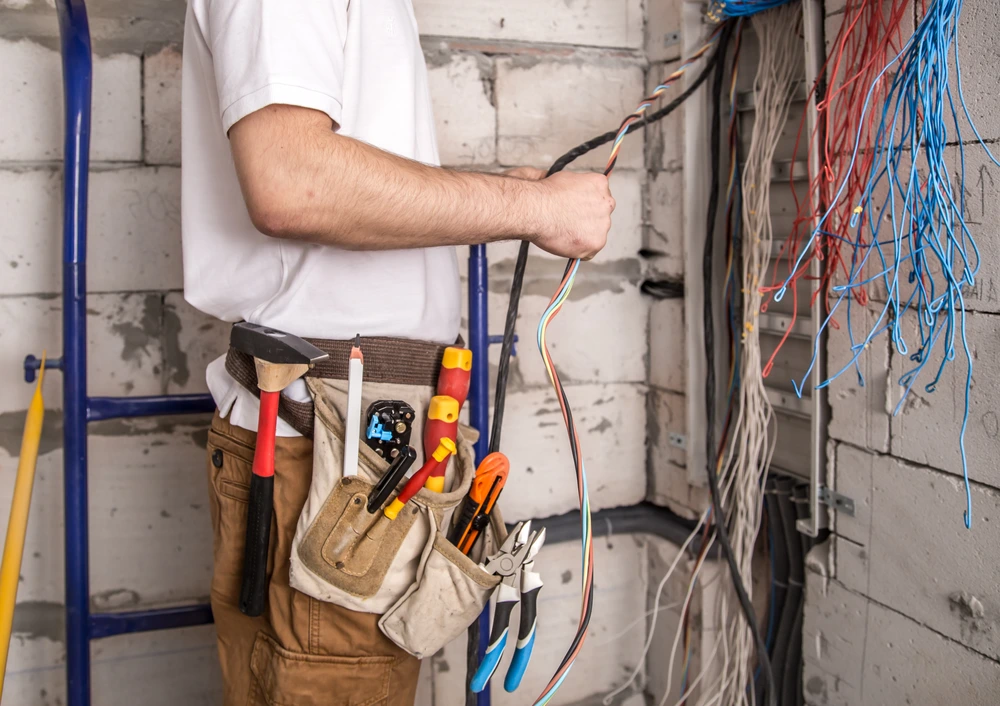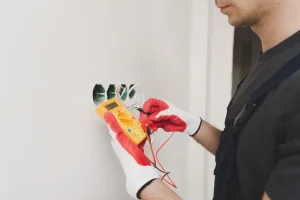Electricity is the backbone of every home, and keeping it safe is essential. In Melbourne, a reliable residential electrician ensures your wiring is secure, efficient, and up to code. Faulty or outdated wiring can cause shocks, damage appliances, or even start fires. Knowing how to maintain your home’s electrical system and when to call a professional can save you time, money, and stress.
Electrical safety isn’t just about avoiding burnt fingers. Outdated or damaged wiring is a hidden hazard. In Victoria alone, fire crews attend over 300 domestic electrical fires each year, often caused by old or degraded wiring. That’s why you should treat home wiring with the same vigilance as smoke alarms; a little attention now can prevent tragedy later.
In this guide, we’ll share expert tips to help you maintain safe home wiring, stress why hiring a licensed residential electrician in Melbourne is crucial, and what to look for in maintenance and upgrades to prevent dangers down the track. You’ll learn how to perform simple checks safely, and why never do your own rewiring. By the end, you’ll feel confident about keeping your home’s electrical system safe.
Why Hire a Licensed Residential Electrician
You might be handy around the house, but electricity is not a DIY project. In Australia, legal regulations mandate that almost any substantial electrical work be done by a licensed electrician.
While trying to fix a mysterious wiring fault, one wrong connection could lead to fire or electrocution. Licensed residential electricians undergo years of training to read wiring diagrams, use proper tools, and follow the national Wiring Rules (AS/NZS 3000). They must also provide a certificate of electrical safety when they finish work.
Hiring a professional also means you get the right equipment. They will install safety switches, circuit breakers, surge protectors, and use proper insulation, all gear that homeowners might overlook. And if something goes wrong, a licensed electrician carries insurance. Unlicensed work voids this protection. In short, calling a local residential electrician means you can sleep easily knowing the wires were handled by an expert.
Understanding Your Home’s Wiring and Safety Devices
The network of wires inside your home’s switchboard may look like spaghetti, but each cable and switch serves a vital purpose. Inside that panel, you’ll find separate circuits for lights, outlets, kitchen appliances, etc. Key protective devices here include circuit breakers and safety switches (also called Residual Current Devices or RCDs). Circuit breakers stop overloads and short circuits, while safety switches can cut power in milliseconds if they detect stray current, possibly saving your life.
How a safety switch works: it constantly monitors the flow of electricity, and if even a tiny leak is detected, it instantly turns off the power within 0.03 seconds. This is why properties built after 2000 usually have safety switches on each circuit. Older homes often had only a single switch for the whole house, an unreliable setup by modern standards.
Beware of Old and Faulty Wiring
If your house is older, special caution is needed. Homes built before about 1980 may have cloth-insulated or degraded rubber wiring that can crumble. Energy Safe Victoria warns that old wiring can’t cope with modern electrical demands and often leads to house fires or worse.
Signs your wiring might be due for replacement include flickering lights, outlets that feel warm to the touch, frequent breaker trips, or discolored outlet plates. These indicate hidden wear or overloading. Don’t ignore them! Older wiring can expose live metal or fail to shut down in a fault. If you spot anything unusual, shut off the circuit and call a professional. Handling old, high-voltage wiring is beyond DIY.
Essential Home Electrical Maintenance
Even well-installed wiring needs some TLC. Here are practical tips to maintain safe home electrical systems:
Visual Inspection: Every few months, look over power points, cords, and appliances. Replace frayed cables and cracked plugs. Make sure extension cords are not pinched under rugs or overloaded. Loose or rusty outlets should be repaired by an electrician.
Safety Switch Testing: As mentioned, use the built-in test button on each safety switch twice a year. Mark it on your calendar.
Avoid Overloads: Don’t daisy-chain power boards or plug too many high-power devices into one outlet. Spread out appliances among circuits and consider adding extra outlets if needed.
Keep Dry: Water is electricity’s enemy. Make sure switchboards, outlets, and electrical appliances stay dry. Never use devices with wet hands, and avoid DIY over outlets in bathrooms or kitchens.
Fuse & Breaker Check: Occasionally, check your meter box to ensure fuses haven’t corroded or breakers tripped. If a fuse keeps blowing, that’s a red flag for a wiring issue that needs a pro’s attention.
Professional Inspection: It’s a good idea to have a licensed electrician perform a home safety inspection every 5–10 years, or whenever you buy or renovate a home. They will check wiring integrity, earth leakage, circuit protection, and earthing systems. Don’t take chances with neglected systems.
Common Residential Electrical Services
What does a residential electrician do? Here are typical services they offer to keep your home wiring safe and up to date:
Electrical Repairs: Fixing flickering lights, dead outlets, faulty switches, power surges, and replacing damaged wires. Tiny sparks or odd smells from outlets? An electrician should investigate before it becomes hazardous.
Home Wiring Services and Rewiring: Upgrading old knobbed-wire systems, adding new circuits for remodels, or completely rewiring an older home. If you renovate a kitchen or bathroom, you’ll need new circuits and outlets that meet code.
Safety Upgrades: Installing safety switches (RCDs) and smoke alarms as required by law. Modern homes should have one RCD per circuit and at least one interconnected smoke alarm per level.
Switchboard Upgrades: Older switchboards with fuses can be unreliable. Upgrading to a modern board with circuit breakers and RCDs improves safety and may handle more power for EV chargers or extra appliances.
Lighting Installation: Mounting new light fixtures, replacing halogen downlights with energy-efficient LED downlights, and wiring new ceiling fans or exterior lights. These tasks require secure wiring and proper fitting to prevent fire hazards.
Electrical Upgrades: Adding power for air conditioners, spa pools, stoves, or EV chargers often involves higher voltages or currents. Electricians ensure the service cable and meter can handle these demands.
Emergency Electrician Services: 24/7 response to dangerous issues like blackout faults, circuit breaker trips that won’t reset, sparking wires, or water-damaged electrical systems.
When to Call an Emergency Electrician
Certain situations demand immediate action:
Persistent Power Loss: If a breaker trips immediately after resetting, or multiple circuits fail, there may be a short circuit. Keep the power off and call an electrician.
Burning Smell or Smoke: Any smell of burning plastic/insulation from an outlet or switch is an emergency. Turn off the power at the main switch and phone an electrician.
Sparks or Arcing: If you see sparks from a socket or hear a crackling sound, power down and get help.
Water Incursion: As mentioned, if your home floods (even minor leaks onto sockets), consider powering off and calling a professional right away.
After a Natural Disaster: Earthquake or bushfire, smoke can damage wiring invisibly. A licensed electrician should inspect your system before normal use.
Overloaded Circuits: Frequent tripping under normal use suggests hidden faults or a need to upgrade capacity.
Conclusion
Safe home wiring is a vital but often overlooked part of home maintenance. The main takeaway is to be proactive: hire licensed professionals, keep safety devices up to date, and watch for warning signs. We’ve covered why a licensed residential electrician in Melbourne is irreplaceable for any wiring job, from routine upgrades to urgent repairs. Remember that equipment like safety switches and well-maintained switchboards is your first line of defense. Test your RCDs, avoid overloading circuits, and don’t hesitate to call an expert if something feels wrong.
By following these expert tips, you’re not just avoiding inconvenience; you’re protecting your family and property. Electrical mishaps can be subtle until they’re not, so make safety your habit. That means scheduling inspections on older homes, upgrading outdated panels, and ensuring every new electrical job is done by a professional.
If you ever need reliable help, Eleco Electrical & Data is here for Melbourne homeowners. From emergency repairs and switchboard upgrades to installing energy-efficient lighting, data cabling, and beyond, our licensed electricians have you covered. Contact us today and let the pros handle your home wiring needs so you can rest easy.
FAQs:
-
Why should I hire a licensed residential electrician?
Licensed electricians have the training and legal credentials to ensure your wiring meets safety standards. DIY electrical work can void insurance and even attract fines. Authorities stress that only licensed contractors should perform wiring tasks.
-
How can I maintain safe wiring in my home?
Simple checks go a long way. Test safety switches (RCDs) every 6 months, inspect power cords for wear, and avoid overloading outlets. Keep your switchboard clean and dry. For older homes, consider scheduling a professional safety inspection. A thorough check by a licensed electrician can catch hidden problems early.
-
What qualifies as a home electrical emergency?
Any sudden electrical faults like smoke, sparks, persistent outages, or water damage should be treated as emergencies. In general, if you smell burning or see arcing, shut off power and call an emergency electrician right away.



